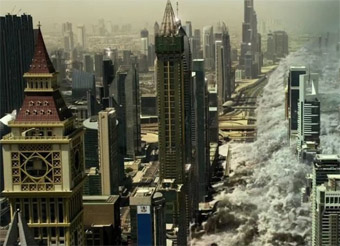
Image courtesy of Warner Brothers/Skydance Media
Geo Storm
| published November 8, 2017 |
By Cameron Dale, Thursday Review contributor
What if global warming got much worse, leading to even more catastrophic climate changes and severe weather tantrums? And what if we turned to technology not to reverse those changes, but to instead simply control and manage the weather? Unable to muster the political courage to reverse our carbon footprint, what if we deployed instead a massive, all-encompassing network of weather management devices—around the globe—to micromanage everything from ocean tides to river levels, from rain to snow to ice, from heat to cold to moderation, even to seasons?
Such is the wide screen premise of Geostorm, written and directed by Dean Devlin, and starring Gerard Butler, Jim Sturgess, and Andy Garcia. In the not too distant future, the Earth's weather and climate problems have been banished to the dustbin of scientific history, replaced instead by postcard picture perfect atmospheric conditions to every corner of the globe—an elaborate array of satellites in geo-stationary orbit.
But, like in that song by Blue Oyster Cult, nature points out the folly of men. Thus the morality play: when technonology fails (perhaps even through a deliberate act of sabotage), those weather machines unleash holy havoc and big-budget Hollywood disaster.
Put another way: what if Hollywood special effects became so sophisticated that the traditionally critical dual elements of narrative inspiration and story originality became pointless, and instead were replaced by elaborate machines and digital computers which crank out a tepid rehash of every well-known disaster film including those from the 1970s (Earthquake, Airport, Towering Inferno) and from the more recent decades (2012, Armageddon, Independence Day, Deep Impact)? Would the power of the special effects outweigh the flimsy plot, clumsy writing, and weak casting?
Well, end-of-the-world fans, you decide. The apocalyptic $137 million Geostorm struck me as threadbare from the get-go, despite an earnest and seemingly unstoppable series of inducements in the form of bigger-than-life weather-related catastrophes, from tornadoes to tsunamis to airline crashes, with lots of zero-gravity space antics thrown in for good measure. Add to the mix: a huge political convention in Orlando, Florida where the President is awaiting re-nomination, but where the next wave of weather absurdities may any moment strike, paving the way for a coup d’état by a rogue State Department underling, who, as it turns out, may have been behind the entire malfunction from the start. Skyscrapers topple, airliners fall from the sky, viscous winds and tornadoes rake through cities and suburds alike.
It’s a lot to take in, and even more for which to suspend disbelief. It’s even more to swallow as a coherent story—and especially painful to digest when one senses uncomfortably how much of it is stolen, cribbed, swiped, rehashed or otherwise regurgitated from other movies over a 40 year span. At long last Hollywood has taken its penchant for retreading the tires and set itself on fire, an act of self-immolation which destroys two thirds of the planet, a thousand high rise buildings, ten trillion dollars’ worth of futuristic bric-a-brac, and three quarters of all the space junk to boot. This is how the world would end if Hal Lindsey and the Mayans had unlimited budgets.
It explains why the film first produced uniformly bad reviews back last year, when the test audiences rated Geostorm an Earth-sized stink-bomb. Horrified by the negative screenings, it also explains how after a dozen new editors, scores of reshoots, and endless reworking in the studio editing rooms the movie did not progress very far, though the extra work may have taken some of the odor off the overall package.
Still, let it not be said I never offer a kind word—or two—now and then. The special effects are dazzling and guttural, pleasing in a way that exceeds on the big screen. In that sense, the film succeeds. See this at your own risk. Or, wait and catch it one day at home.
Ironies abound: the film was released six weeks after Hurricane Irma lashed and bashed Florida, impacting all but a dozen counties and unleashing flooding never before recorded, and a month after Hurricane Maria effectively scoured Puerto Rico, knocking out power, phone, cellular service, water pumping, and internet to the entire island. The movie was also shot mostly in and around New Orleans, a strange homage, I am certain, to more rampant unbound weather wrought by global warming and shifting climate conditions. In that sense, the big-budget movie's timing was prescient, even it its heart and soul are largely missing.
Related Thursday Review articles:
Blade Runner 2049: Lower-Than=Expected Numbers; Thursday Review staff writers; Thursday Review; October 13, 2017.
Dark Tower Topples, Crumbles as Film; Maggie Nichols; Thursday Review; August 16, 2017.
